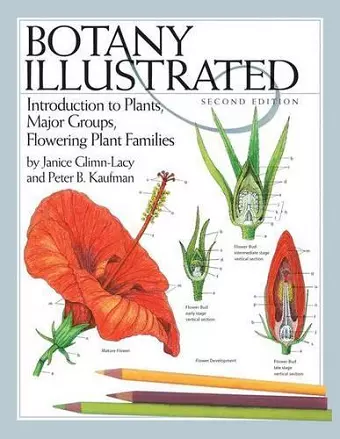Botany Illustrated
Introduction to Plants, Major Groups, Flowering Plant Families
Janice Glimn-Lacy author Peter B Kaufman author
Format:Paperback
Publisher:Springer-Verlag New York Inc.
Published:29th Mar '06
Currently unavailable, and unfortunately no date known when it will be back

2nd edition
Contains 130 pages with text, each facing 130 pages of illustrations. Each page is a separate subject. This guide emphasises on flowering plants, which dominate the earth. It discusses: why leaves "turn" color in autumn; how certain plants devour insects; how a flower develops into a fruit with seeds; how flowers are pollinated; and more.Thisisadiscoverybookaboutplants. Itisforeveryone For those interested in the methods used and the interestedinplantsincludinghighschoolandcollege/ sourcesofplantmaterialsintheillustrations,anexp- university students, artists and scienti?c illustrators, nationfollows. Foradevelopmentalseriesofdrawings, senior citizens, wildlife biologists, ecologists, profes- there are several methods. One is collecting several sionalbiologists,horticulturistsandlandscapedesign- specimensatonetimeindifferentstagesofdevel- ers/architects,engineersandmedicalpractitioners,and ment;forexample,severalbudsand?owersofaplant physicaltherapistsandtheirpatients. Hereisanoppor- (see29)andbuttontomatureformsofmushrooms(see tunitytobrowseandchoosesubjectsofpersonalinter- 50,51). Then,somearecutopentoobservepartsand est,toseeandlearnaboutplantsastheyaredescribed. decidehowtopresentthem,whileothersaretousefor By adding color to the drawings, plant structures be- ?naldrawings. Anothermethodiswaitingfortheplantto come more apparent and show how they function in change,whichinvolves"forcing"stems(see14),ger- life. Thecolorcodecluestellhowtocolorforde?nition natingseeds(see40),watchingoneleafexpand(see andanillusionofdepth. Formoreinformation,thetext 69),anddrawinga?owerinoneseasonanditsmature explains the illustrations. The size of the drawings in fruitinanother(see104,109,110,111). Analternative relation to the true size of the structures is indicated towaitingforfruitistouseacollectionofdryorfrozen by x1(thesamesize)to x3000(enlargementfrom specimens,sothatasspring?owersappear,thelater truesize)and xn/n(reductionfromtruesize). maturingfruitscanbeseenatthesametime(see102, 105,106). The contents re?ect a balanced selection of bota- calsubjectmatterwithemphasison?oweringplants, Inthe?rstsection,introductiontoplants,thereares- the dominant plants of the earth. After a page about eral sources for various types of drawings. Hypoth- plantnamesandterms,thebookisdividedintothree ical diagrams show cells, organelles, chromosomes, sections. The ?rst is an introduction to plants, show- the plant body indicating tissue systems and expe- ingstructureandfunction;then,majorgroups,provid- mentswithplants,and?owerplacentationandrep- inganoverviewofthediverseforms;andlastly,one- ductivestructures. Forexample,thereisnoaverageor seventhofthe?oweringplantfamilies,withtheaccent standard-looking ?ower; so, to clearly show the parts onthoseofeconomicimportance. Thesequenceinthe ofa?ower(see27),adiagramshowsastretchedout sectionsissimpletocomplex(celltoseed),primitiveto and exaggerated version of a pink (Dianthus) ?ower advanced(blue-greensto?oweringplants),andunspe- (see 87). A basswood (Tilia) ?ower is the basis for cializedtospecialized(magnoliastoastersandwater- diagrams of ?ower types and ovary positions (see plantainstoorchids). Whereappropriate,an"ofinter- 28). Another source for drawings is the use of p- est"paragraphlistswaysthesegeneraarerelevantin paredmicroscopeslidesofactualplanttissues. Some ourlives(categoriesincludeuseasfood,ornamentals, are traced from microscope slide photographs such lumber,medicines,herbs,dyes,fertilizers;noticeofwild ascross-sections,vascularbundles,andtransections. or poisonous; and importance in the ecosystem).
ISBN: 9780387288703
Dimensions: unknown
Weight: unknown
278 pages
2nd ed. 2006